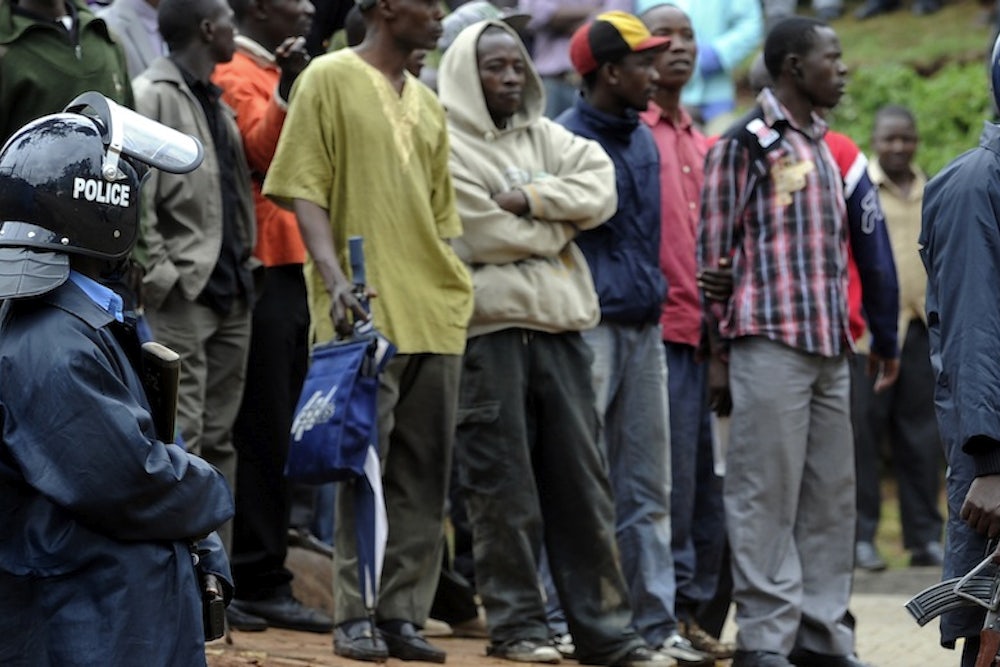It has been a gruesome 48 hours. On Saturday, in Kenya, at least 68 people were slaughtered when gunmen from Somalia's Shahab extremist group entered a mall and started firing indiscriminately. (Or perhaps not entirely indiscriminately: The New York Times reports that witnesses claimed Muslims were told to run away). In Pakistan, at least 78 people were killed when suicide bombers attacked All Saints Church in the city of Peshawar. The church was built over 125 years ago, and had stood as a symbol of intercommunal harmony. (No one has yet taken credit for the bombing, so it isn't obvious which Taliban wing is responsible). In Iraq, 95 people were killed on Saturday, mainly in a bombing at a Shiite funeral procession in Baghdad.
The Kenya news is currently the lead story on the Times's website, and it was the lead story in Sunday's paper. Pakistan is currently the second story on the Times's website, but the bombing occurred after the print edition came out. As for the Iraq story, I came across it on page 11 in the form of a short AP report that the Times reprinted. The placement is essentially the same on The Washington Post's website, although I am having trouble finding the Iraq story at all.
There are several things that drive the disparity in coverage. The first is the surprise factor. Kenya is a much more peaceful place than Pakistan or Iraq, and isn't accustomed to large scale attacks. Sectarian violence in Iraq is the norm, and attacks on minorities Pakistan have become part of daily life. Thus, even though Kenya saw the fewest casualties, it is the biggest story.
The second factor that determines coverage is the larger political context. So, the Kenya attack is a sign that Somali terrorist groups are really bad, and that the conflict there can spill across the border. (Predictably, the Shahab said the attack was in response to Kenyan interference in Somalia). In Pakistan, the larger issue is violence against non-Sunni Muslims and other minorities. And in Iraq, it's the same old story of the past decade.
The third factor arises from the connection between what is news and what is new. The Kenya attack simply feels different. It wasn't a suicide bombing. It wasn't an IED. It was a bunch of lunatics entering an environment everyone recognizes and firing weapons indiscriminately. When you look at the photos taken in Kenya, the places are familiar. The store aisles look like our own. The Pakistan attack, similarly, is probably getting more coverage than attacks in that country normally do because the site of the bombing was a church. That somehow feels even more grotesque than a normal bombing.
This tendency to expend more ink on attacks that are distinct holds true for atrocities that take place here, too. Bombings are rare in America and thus the Boston Marathon attack managed to shut down a city and dominate news coverage for weeks. A little over a month later, a man in Santa Monica went on a killing spree and murdered five people, two more than in Boston. The only reason I heard about it was that I have family in Los Angeles. (There were other differences between these two cases, but if the lunatic in Southern California had set off bombs it would have been much bigger news).
There is something perverse about the proportional relationship between the creativity of attacks and the attention they garner. "Don't let the terrorists win" is the silliest cliche we have, but it is still worth trying to modulate our reactions. If not necessarily terrorized by new or different forms of violence, we too often seem spellbound by them. Something tells me the people behind these acts, and those who hope to follow in their footsteps, don't mind that one bit.
Isaac Chotiner is a senior editor at The New Republic. Follow him @IChotiner.
